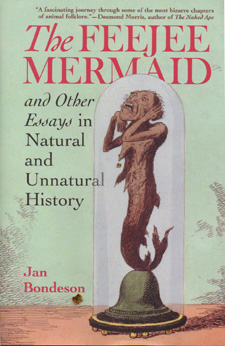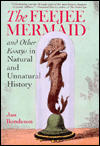August 4, 2007
Gordon Rutter, a professional botanist and well-known collector of Fortean artifacts, wrote me: “I was in London last week and whilst in the British Museum I stumbled across a rather fine Feejee mermaid which I did not know they had!”
Gordon shares the above photograph with Cryptomundo, of what he found.
Gordon decided to write the museum and discover more about what was being exhibited:
From: Gordon Rutter
Sent: Sun 29/07/2007 19:36
To: Collection Enquiries
Subject: Collection RequestDear Sir
On a recent visit to the museum I chanced upon a Mermaid exhibit in the George II library. There was no information next to this exhibit, but based on it’s location I took it to be part of the Hans Sloane collection. I now believe this to be incorrect and that it is in fact a much later addition to the Museum’s collection – I believe it is actualy a nineteenth century example, formerly the property of Prince Arthur of Connaught. Could you shed any ligth on the past history of this exquisite object?
Thank youGordon Rutter

Hi Loren
Here is the reply from the BM – shame it’s not a Hans Sloane original!
It is still a rather fine example and, when Jan was looking into it it was locked away in storage.
I know the Royal Museum here in Edinburgh has several none of which are on display.
Cheers
Gordon Rutter

Dear Mr. Rutter,
Thank you for your email. The item you spotted in the Enlightenment Gallery belongs to the Museum department of Asia. It was indeed donated by Prince Arthur, Duke of Connaught and Strathearn, and acquired by the British Museum in 1942. This mermaid figure is composed of the upper part of a monkey’s body and a fish’s tail with various additions. On the acquisitions notes of this item we read: “1942: Japan. Said to have been caught over 200 years ago.”
Please find additional information below:
“Prominent in ancient, medieval and modern mythology, mermaids (and less usually, mermen) were presented as three-dimensional curiosities in European drawing-rooms and popular sideshows from at least the seven-theenth century. A significant number of these seem to have originated in East Asia, especially in Japan.
Such ‘mermen’ consist of the dried parts of monkeys, with fish tails, probably on wood cores. The British Museum example, donated by HRH Princess Arthur of Connaught, was said to have been caught in Japan in the eighteenth century and to have been given to Prince Arthur by one Seijiro Arisuye” (Bryan Durrans)
Pg 85, ‘Fake? The art of deception’. Edited by Mark Jones. University of California Press, Berkeley and Los Angeles, 1990.
Hope you find this information useful.
Yours sincerely, Eva Nueno, PHL Assistant, Learning and Audiences, British Museum
About Loren Coleman
Loren Coleman is one of the world’s leading cryptozoologists, some say “the” leading living cryptozoologist. Certainly, he is acknowledged as the current living American researcher and writer who has most popularized cryptozoology in the late 20th and early 21st centuries.
Starting his fieldwork and investigations in 1960, after traveling and trekking extensively in pursuit of cryptozoological mysteries, Coleman began writing to share his experiences in 1969. An honorary member of Ivan T. Sanderson’s Society for the Investigation of the Unexplained in the 1970s, Coleman has been bestowed with similar honorary memberships of the North Idaho College Cryptozoology Club in 1983, and in subsequent years, that of the British Columbia Scientific Cryptozoology Club, CryptoSafari International, and other international organizations. He was also a Life Member and Benefactor of the International Society of Cryptozoology (now-defunct).
Loren Coleman’s daily blog, as a member of the Cryptomundo Team, served as an ongoing avenue of communication for the ever-growing body of cryptozoo news from 2005 through 2013. He returned as an infrequent contributor beginning Halloween week of 2015.
Coleman is the founder in 2003, and current director of the International Cryptozoology Museum in Portland, Maine.
Filed under Artifacts, Cryptomundo Exclusive, Cryptotourism, CryptoZoo News, Cryptozoologists, Cryptozoology, Evidence, Forensic Science, Hoaxes, Lizard People, Merbeings, Museums, Photos